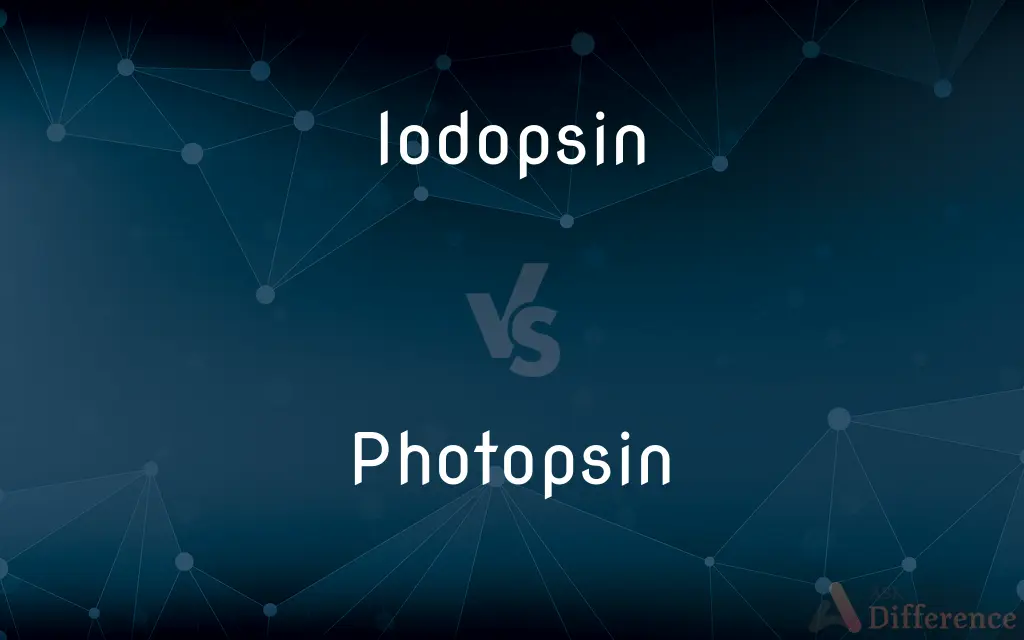Iodopsin vs. Photopsin — What's the Difference?
By Tayyaba Rehman & Fiza Rafique — Updated on March 8, 2024
Iodopsin is a photoreceptor protein found in cones for bright light and color vision, while photopsin refers to its opsin component sensitive to different light wavelengths.

Difference Between Iodopsin and Photopsin
Table of Contents
ADVERTISEMENT
Key Differences
Iodopsin is crucial in the human eye's cones, facilitating color vision and functioning optimally in bright light. It enables the perception of finer details and a wide range of colors. Whereas photopsin is the specific protein within iodopsin responsible for absorbing light at various wavelengths, directly influencing color differentiation.
Iodopsin's presence in cone cells allows humans to see in conditions of bright light, supporting activities like reading and distinguishing colors clearly. On the other hand, photopsin variations (S-opsin, M-opsin, and L-opsin) correspond to different light wavelengths (blue, green, and red, respectively), playing a key role in color vision.
The effectiveness of iodopsin in bright light contrasts with rhodopsin's function in rods, which is more suited for low-light conditions. Whereas photopsins, as components of iodopsin, are specialized to capture light across the visible spectrum, enhancing color perception and visual acuity in well-lit environments.
Iodopsin's role in color vision is a result of the combination of its different photopsins, which are sensitive to specific portions of the light spectrum. This contrasts with the singular role of rhodopsin in rods for night vision. On the other hand, the variation in photopsin types within iodopsin allows for a broad spectrum of color vision, from short wavelengths (blue) to long wavelengths (red).
Understanding the interplay between iodopsin and its photopsins is crucial for grasping how the eye adapts to various lighting conditions and processes color. Photopsins, by absorbing different wavelengths, enable the nuanced perception of colors, while the broader category of iodopsin signifies the eye's ability to operate under bright conditions.
ADVERTISEMENT
Comparison Chart
Function
Facilitates color vision in bright light
Absorbs specific wavelengths for color vision
Location
In cone cells of the retina
Component of iodopsin in cone cells
Role in Vision
Enables high acuity and color differentiation
Determines sensitivity to color wavelengths
Types/Components
Comprised of different types of photopsins
S-opsin, M-opsin, L-opsin (based on sensitivity to light spectrum)
Importance
Essential for visual activities in daylight
Key to distinguishing colors
Compare with Definitions
Iodopsin
Contains photopsins sensitive to different light wavelengths.
Iodopsin's composition includes three types of photopsins for color perception.
Photopsin
The opsin component of iodopsin, sensitive to specific light wavelengths.
Photopsins are vital for detecting different colors.
Iodopsin
Operates optimally in well-lit environments for color discrimination.
Iodopsin is crucial for reading and recognizing colors in sunlight.
Photopsin
Each type is tuned to specific segments of the visible spectrum.
Photopsins' sensitivity to different wavelengths enables nuanced color vision.
Iodopsin
Enables the eye to adjust to bright lighting conditions.
In bright outdoor settings, iodopsin plays a key role in visual adaptation.
Photopsin
Includes S-opsin, M-opsin, and L-opsin, each absorbing distinct wavelengths.
Photopsins vary to absorb blue, green, and red light, respectively.
Iodopsin
Supports high visual acuity and detailed color vision.
Thanks to iodopsin, we can distinguish fine details and a spectrum of colors.
Photopsin
Directly influences the eye's ability to differentiate colors.
The presence of various photopsins allows for the perception of a wide color range.
Iodopsin
A photoreceptor protein in cone cells aiding color vision in bright light.
Iodopsin allows humans to see vivid colors during the day.
Photopsin
Absorbs light to initiate the visual phototransduction pathway.
Photopsins absorb light, triggering signals for color vision processing.
Iodopsin
Any of a class of light-sensitive pigments found in the retinal cones of the vertebrate eye.
Photopsin
Photopsins (also known as Cone opsins) are the photoreceptor proteins found in the cone cells of the retina that are the basis of color vision. Iodopsin, the cone pigment system in chicken retina, is a close analog of the visual purple rhodopsin that is used in night vision.
Iodopsin
A photoreceptor protein found in the cone cells of the retina, the basis of colour vision.
Photopsin
(protein) Any of a class of photoreceptor proteins present in the cones of the retina
Iodopsin
A violet photopigment in the retinal cones of the eyes of most vertebrates; plays a role in daylight vision
Common Curiosities
How do iodopsin and photopsin relate to each other?
Iodopsin contains photopsins, which are crucial for its function in color vision.
What is iodopsin?
Iodopsin is a protein in the cone cells of the retina that aids in color vision and operates best in bright light.
Why is iodopsin important for vision?
It enables high acuity and color discrimination in bright lighting conditions.
Are photopsins present in rod cells?
No, photopsins are specific to cone cells and are integral to color vision.
What are photopsins?
Photopsins are the opsin components of iodopsin, each sensitive to different light wavelengths, enabling color vision.
Can the absence of certain photopsins affect vision?
Yes, deficiencies in specific photopsins can lead to color vision deficiencies or color blindness.
Is the function of photopsins affected by the intensity of light?
Yes, their ability to absorb light and trigger visual signals varies with light intensity.
What roles do different types of photopsins play?
They absorb specific wavelengths of light, allowing for the perception of a wide range of colors.
Can iodopsin function in low light?
Iodopsin is designed for bright light conditions; in low light, rod cells and rhodopsin are more effective.
How do photopsins influence the eye's adaptation to light?
They enable the eye to adjust and perceive colors accurately under varying lighting conditions.
How do iodopsin and photopsins contribute to detailed vision?
They enable the perception of fine details and a wide range of colors in bright environments.
How does the presence of various photopsins affect color vision?
It allows the eye to distinguish colors across the visible spectrum by absorbing different wavelengths.
What is the difference between rods and cones in terms of photoreceptor proteins?
Rods contain rhodopsin for low-light vision, while cones contain iodopsin (with photopsins) for color vision in bright light.
What happens to iodopsin in dim light?
Its effectiveness decreases, and the eye relies more on rhodopsin in rod cells for vision.
Can the study of iodopsin and photopsins help understand visual disorders?
Yes, understanding these proteins is crucial for diagnosing and treating color vision disorders and other visual impairments.
Share Your Discovery

Previous Comparison
Beneathe vs. Beneath
Next Comparison
Pocketbook vs. PurseAuthor Spotlight
Written by
Tayyaba RehmanTayyaba Rehman is a distinguished writer, currently serving as a primary contributor to askdifference.com. As a researcher in semantics and etymology, Tayyaba's passion for the complexity of languages and their distinctions has found a perfect home on the platform. Tayyaba delves into the intricacies of language, distinguishing between commonly confused words and phrases, thereby providing clarity for readers worldwide.
Co-written by
Fiza RafiqueFiza Rafique is a skilled content writer at AskDifference.com, where she meticulously refines and enhances written pieces. Drawing from her vast editorial expertise, Fiza ensures clarity, accuracy, and precision in every article. Passionate about language, she continually seeks to elevate the quality of content for readers worldwide.














































